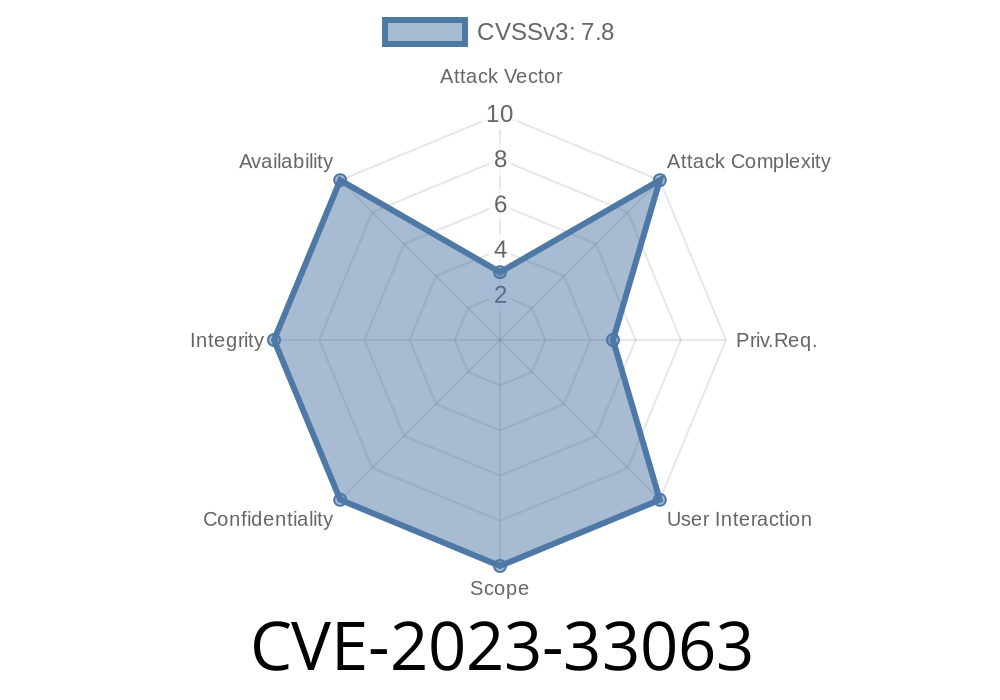A recently discovered vulnerability, CVE-2023-33063, has been identified in the Digital Signal Processor (DSP) services software, which is widely used in modern smartphones and IoT devices. This vulnerability can allow malicious actors to exploit memory corruption in the DSP services during remote calls from the High-Level Operating System (HLOS) to the DSP. In this post, we will discuss the details of the vulnerability, show a code snippet to demonstrate the issue, provide links to original references, and discuss potential exploits and mitigations to protect your devices.
Background
DSP services software is responsible for handling complex mathematical processing tasks that involve digital signals like audio, video, and sensor data. This software usually resides in a separate, low-power processor that works in conjunction with the main CPU of the device. In smartphones, DSP is responsible for handling tasks such as voice processing, noise reduction, and gesture recognition. The HLOS, or main operating system of the device, communicates with the DSP to offload certain tasks and enable power-efficient processing.
The Vulnerability
CVE-2023-33063 is a memory corruption vulnerability that can be exploited by attackers during remote calls between the HLOS and DSP. Due to improper input validation and incorrect handling of certain data structures, the DSP may overwrite memory regions outside of the intended boundaries during execution, leading to memory corruption.
A brief code snippet that demonstrates the vulnerability is as follows
// Remote call from HLOS to DSP
int remote_call(int request, void *request_data, size_t data_size) {
int result;
// Check if data_size is within limits
if(data_size > MAX_ALLOWED_SIZE) {
return -EINVAL;
}
// Copy request data to DSP memory
memcpy(dsp_mem_ptr, request_data, data_size);
// Process the request
result = dsp_process_request(request, dsp_mem_ptr);
return result;
}
In this sample code, the remote_call() function is responsible for handling incoming requests from HLOS, copying them to DSP memory, and processing them using the dsp_process_request() function. The vulnerability arises from the insufficient validation of the data_size parameter, allowing the attacker to pass a large value that might exceed the size of the target memory buffer. This can lead to memory corruption and subsequent exploitation by an attacker.
Original References
1. The official CVE entry: https://cve.mitre.org/cgi-bin/cvename.cgi?name=CVE-2023-33063
Exploit Details
An attacker could exploit this vulnerability to cause a range of malicious effects, such as crashing the DSP services, causing the device to reboot, or potentially executing arbitrary code on the device. In the case of remote exploitation, the attacker would need to craft a malicious request, bypass authentication mechanisms, and invoke the vulnerable remote call with a specifically crafted payload to trigger the memory corruption.
In order to protect your devices from this vulnerability, the following steps can be taken
1. Update your device's software as soon as possible if a patch has been released, and continue to apply security updates regularly.
2. Employ strong security measures in your network to prevent unauthorized access. Configure firewalls, intrusion detection systems, and access controls to minimize the likelihood of a successful attack.
3. Be cautious when downloading third-party applications or opening files from untrusted sources to minimize the risk of exploitation.
Conclusion
Memory corruption vulnerabilities like CVE-2023-33063 are a significant threat to modern smartphones and IoT devices, particularly when attackers can exploit them remotely. It is crucial for developers to implement proper checks and input validation, while end-users must maintain strong security practices to keep their devices safe. By staying informed about such vulnerabilities and taking appropriate mitigations to protect your devices, you can minimize the risk of becoming a victim of a targeted attack.
Timeline
Published on: 12/05/2023 03:15:12 UTC
Last modified on: 12/11/2023 18:20:10 UTC
